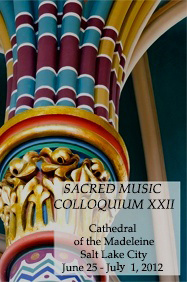Stop what you are doing and either bookmark this or go to read this essay right now. HERE
Disintegration: What the ‘Folk’ Style Hath Wrought
Benedict XVI makes a startling observation in suggesting that the Constitution on the Sacred Liturgy has produced an attitude of opposition within the Church–a partisan and opposing church tearing herself apart (A New Song for the Lord, 142). The Matthean verse, “where two or three are gathered together in my name (Mt 18:20) is used to oppose the institution and every official program of the Church. This verse becomes the place of origin for the liturgy. The group arises on the spot from the creativity of those gathered (Ibid, 145). The institution and the clerical Orders represent a negative image of bondage, opposed to genuine freedom. This new attitude is expressed through the new music by the people of God, and it is the music which gives identity to the group.
The new music is the characteristic of the group’s identity, the emergence of another church. For this group, the content of Pope St. Pius X’s motu proprio on church music is called a “culturally shortsighted and theologically worthless ideology of sacred music” (Ibid., 144). Gregorian chant and Renaissance polyphony symbolize the power of the institution and the clergy–the other church, which curtails the group’s freedom. The pontiff writes that the “treasury of musica sacra, the universality of Gregorian chant handed down through the ages, now appears as an outmoded and quaint practice of the pre-conciliar Church for the purpose of preserving a certain form of power” (Ibid).
Disintegration is not a pretty word, but Benedict XVI uses it to capture the liturgical crisis in the Church today. A thing deteriorates when its natural form is so disfigured that the purpose for which it was intended is no longer recognizable. It is not simply irreverent music. At issue is that the faithful have become the Church, and they are celebrating themselves through the folly of faddism.
66 Responses to A superb essay on Sacred Music
http://wdtprs.com/blog/2012/09/a-superb-essay-on-sacred-music/
http://www.catholicnewsagency.com/column.php?n=2301
http://www.catholicnewsagency.com/column.php?n=2301

We could call her the Symphonic Doctor, not only to honor her own superb compositions, which topped the classical music charts years before theologians got around to rediscovering her, but for the extraordinary theology of music she provides. St. Hildegard weaves the music of the Opus Dei into the very fabric of salvation history, seeing within it a most powerful tool against the Devil because it reflects the musical harmony of paradise. For her, music rises almost to the level of a sacrament, channeling the perfection of divine grace from the heavenly choirs down to us, where we reflect the symphony in the blessed joy of song.
If only that were how our church musicians today approached their sacred craft…
3) Songs with jerky, heavy, frenzied rhythms, or dance rhythms found in popular culture: #302, Gather Us In; #374, City of God; #447, Though the Mountains May Fall; #452, Blest Be the Lord; #495, Let There Be Peace on Earth, the perfect song for Bette Midler; #548, Sing to the Mountains, Sing to the Sea; #578, Sing a New Song Unto the Lord; #548 and #578 are cast in the style of a brindisi, a drinking song similar to that sung in Verdi’s La Traviata.